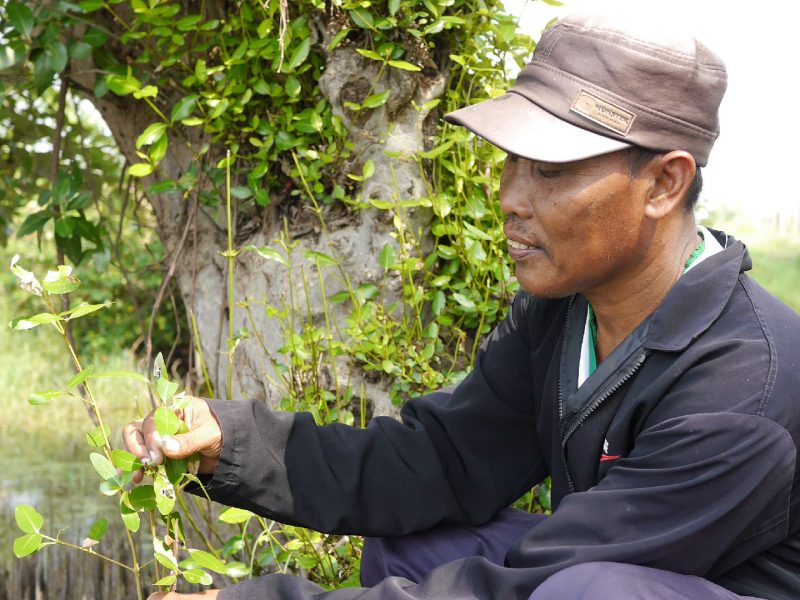Safeguarding A Coastal Community with Silvofishery

This success story is by Enggar Paramita, Communication Specialist USAID APIK. It was originally published on the USAID-APIK website on July 27, 2018.
Read this article in Indonesian.
Climate impacts on coastal community livelihoods
The smell of the ocean fills the air as soon as you enter Segoro Tambak village, Sidoarjo district, East Java. At the side of the road, a lineup of fishmongers sell freshly harvested mussels, fish, shrimp, and squids in various sizes. In the Javanese language, the word ‘Segoro’ means the sea, while ‘Tambak’ is translated as fishpond. Together, the name Segoro Tambak insinuates a vast pond, an ideal dubbing for the coastal village as the home of fisherfolk and fish farmers.
Suryanto, a fish farmer from the village, said that he inherited ponds from his father. Suryanto has two ponds, with a total size of six hectares, where he breeds vaname shrimp (also known as Pacific white shrimp), tiger shrimp, milkfish, and parrotfish. According to Suryanto, who is also a member of the climate change adaptation and disaster reduction forum (Forum API-PRB), nowadays fish farming has become more challenging as the sea waves often breaches embankments and washes away fish. “Because of the wave, we have to harvest early, and this means the fish and shrimp have not reached their ideal size, so the selling price is cheaper. If we wait longer, the wave will damage our ponds. It is devastating,” said Suryanto.
Silvofishery as a sustainable fishery technique
A participatory climate vulnerability and risk assessment USAID Adaptasi Perubahan Iklim dan Ketangguhan (USAID APIK) conducted in 2017, validated Suyanto’s experience, noting that the tidal wave has occurred repeatedly in Segoro Tambak, threatening a community that is 80% dependent on fisheries. During focus group discussions, community members underlined that the tidal wave is getting higher. They also remembered how the tidal wave became regular as it happened in 2010, 2013, 2015, and 2017. The wave not only gushed over embankments but also flooded houses and roads in the village, causing livelihood and infrastructure damage to the fish farmers and the village.
Realizing the urgency of addressing the problem, USAID APIK and community members developed an action plan to fortify the embankments. Collaboration was pursued with Marine and Fisheries Polytechnic of Sidoarjo to apply the silvofishery method. Silvofishery is a sustainable fishery technique that promotes conservation through mangroves cultivation alongside embankments. “The use of silvofishery is twofold. Firstly, the mangrove root system helps to hold soil in place, protecting the ground from tidal wave. Secondly, mangroves create an ideal breeding ground for shrimp, fish, and crabs,” explained Dwi Sukamto, a lecturer at Marine and Fisheries Polytechnic. Further, Sukamto said that, in the 80s, plenty of mangroves covered the embankments in Segoro Tambak, but there was a popular assumption that good embankments were the clean ones with no shade, so people cut down the trees, not knowing that bare areas are more vulnerable to waves.
To implement silvofishery, two hectares of fishponds belonging to Forum API-PRB members were selected as pilot locations. Prior to that, in February 2018, USAID APIK organized a trip for Forum members to visit Pulokerto village in Pasuruan district, which has successfully implemented silvofishery. During the trip, fish farmers from Segoro Tambak gained firsthand experience of how silvofishery works.
In March, the Forum members, assisted by Marine and Fisheries Polytechnic, prepared the pilot locations and planted mangrove seeds. Two types of mangroves, Rhyzopora and Avicennia, were planted next to the embankments. Sukamto said Rhyzopora was opted for because of its root system strength while Avicennia was chosen due to its fast growing ability. Combined, both species will provide resilient protection from tidal waves.
Realizing the benefit of ecosystem-based adaptation
After planting, farmers were assisted in maintaining the young seedlings. Farmers installed protecting nets and cleaned up the weeds. They also monitor the growth regularly. Although it takes years for mangroves to reach maturity, farmers remain motivated. “I was familiar with mangroves because they have been growing in the area for ages, but I never realized that it has many advantages nor had I learned to cultivate it. Then I saw it myself during the trip to Pulokerto village, and I was inspired. I realized that it will take a couple of years before the tree is fully-grown, but I am sure it will be worth it. If I had known it, I would have started planting years ago,” said Kodro, a fish farmer from Segoro Tambak.
Mangroves are renowned as an important component of climate change adaptation and mitigation due to its carbon storage capacities and ability to protect terrain from sea-level rises. Therefore, silvofishery is a suitable adaptation strategy for Segoro Tambak, as it will help strengthen the community’s resilience by protecting and ensuring the sustainability of the village’s livelihood source and environment. Slowly but surely, changes are happening and we are looking forward to a more resilient Segoro Tambak.
Related resources
- Success Story: Safeguarding Coastal Community with Silvofishery
- Read about Best Management Practices for Silvo-Aquaculture in Vietnam and the Mekong [Panorama Solutions website]
- Mangroves for coastal defence: Guidelines for coastal managers & policy makers
- Mangrove Restoration: 'To plant or not to plant?'
- Watch a short video on FAO Policy Series: Sustainable Small-Scale Fisheries [FAO]
- Explore the Network of Aquaculture Centres in Asia and the Pacific
(0) Comments
There is no content